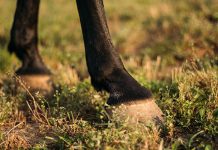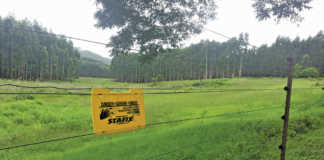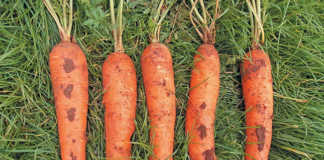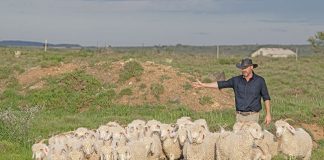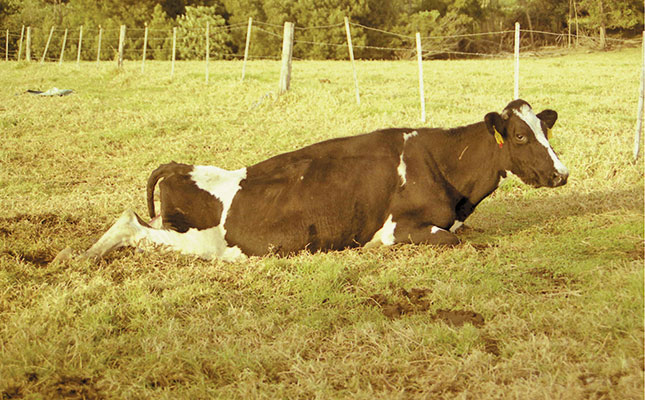
Photo: FW Archive
Most livestock owners have had cattle that lie down and seem unable to stand up on their own. These are called recumbent animals. The main reasons for this problem are:
Malnutrition
In this case, the animal gets too little feed, feed of poor quality, or both. The problem is more common during a dry winter period or drought, and often occurs when the veld is overgrazed.
In-calf cows require good nutrition and are more susceptible to recumbency.
Poor-quality feed lacks the protein and energy needed to maintain the animal in good condition. The animal gradually loses weight until it is too weak to walk short distances or even stand.
An animal suffering from malnutrition is at risk of getting a disease as its immune system is weakened.
Gestation and birth-related problems
Nerves on the inside of the thighs in the rear legs may be injured when a cow has difficulty in calving, or the attendant pulls the calf out roughly. The animal is typically seen sitting down (or lying) in a ‘frog position’.
Thigh muscles, too, are often bruised during a difficult birth because of an oversized calf. Other nerve injuries of the legs occur when an animal has been recumbent for a long period.
Milk fever is another important condition, and may be seen two to three days after calving.
This is caused by calcium deficiency. The muscles of the head and legs begin trembling,
and the cow has difficulty in rising and walking. Eventually she will lie down on her chest, with her neck twisted to the side. Most animals die if not treated within 12 hours.
Fever
Diseases affecting other parts of the body can also result in a recumbent cow due to fever and weakness. These include infection of the udder and uterus, parasites in the blood (gallsickness or redwater), and three-day stiff sickness (bovine ephemeral fever).
Bone, joint and feet problems
Broken bones, dislocated hips, foot rot, arthritis or any spinal problem such as an abscess exerting pressure on the spinal cord can all cause recumbency.
Plant poisoning
Poisoning occurs when animals have ready access to toxic plants. These are usually among the first green plants during spring, and some are the first to appear after a veld fire.
Poisoning also occurs after a sudden change in the weather or when fodder contains toxic plants. Grazing animals tend to prefer fresh, green vegetation, and several species, such as Dichapelatum cymosum (gifblaar), are most toxic in their early growing stage.
Animals that are moved to a new grazing area are more prone to poisoning as they are unfamiliar with the plants and hence less selective in their grazing.
In their ‘home’ area, they can usually distinguish between safe and toxic plants and will avoid the latter unless forced to eat them when no other grazing is available.
Various toxins act in different ways. Plant toxins affecting the nerves and muscles will cause paralysis of the rear legs in ruminants, especially cattle. Toxins affecting the heart, lungs and brain will also cause recumbency, but there will also be other signs.
Treatment
A malnourished animal must receive clean water, good quality feed and adequate nursing as soon as possible. It is also a good idea to administer a multivitamin injection.
If the animal is lying in the sun, move it to a shady place with enough bedding and a
non-slippery floor. Remove dung regularly and keep the floor and bedding clean, dry and warm.
Change the animal’s position by turning it from side to side in the morning, during the day and at night. This minimises muscle damage and prevents pressure sores developing on the hip bones.
Depending on the animal’s size, try to make it stand every day by supporting it under the body with your hands for a few minutes, then let it lie down again. (This can be very difficult; ask for one or more people to help you.)
Give specific treatment based on a proper diagnosis. Consult your state or private vet, or animal health technician, as soon as possible.
Prevention
- Remove dead animals from the veld.
- Avoid overgrazing.
- Feed livestock well during the winter months. Provide licks and supplementary feed.
- Take care when assisting the cow during calving.
- Keep animals away from places where toxic plants occur.
- Vaccinate your herd against botulism.
Will the animal recover?
Recovery depends on how long the animal has been down. If it has been several days, the chances of recovery will not be good, especially with a heavy animal. This is because pressure disrupts the blood flow to the muscles, leading to muscle damage.
An animal that has been recumbent for a long time may also suffer from pneumonia or hip dislocation. It is best to slaughter it before the body condition worsens or it dies.
The likelihood of recovery also depends on the cause of the animal going down. For example, if it is due to milk fever, and this is identified in the early stages of the disease (within about six hours), the chances of recovery are good.
If, however, the cause is a damaged nerve, the animal may not recover.
Source: Mashishi, MSK (2007).
‘My cow is unable to stand up!’. Directorate: Agricultural Information Services, Department of Agriculture, Forestry and Fisheries, and ARC-Onderstepoort Veterinary Institute.
Source: Mashishi, MSK (2007).
‘My cow is unable to stand up!’. Directorate: Agricultural Information Services, Department of Agriculture, Forestry and Fisheries, and ARC-Onderstepoort Veterinary Institute.
This article has been updated, 14 May 2018.






